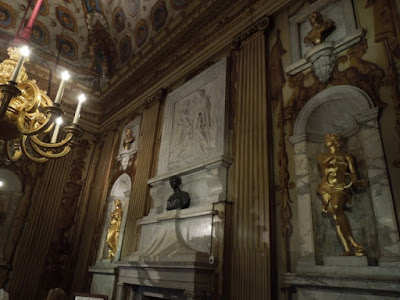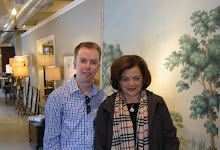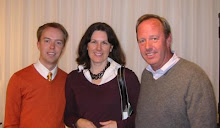One of the many lavish personal residences retained by the British monarchy is Kensington Palace. You may know it as the home of the Duke and Duchess of Cambridge (Will & Kate to some) but it has played as a sort of royal apartment building for centuries.
If you would like to see more of the private apartments of the Duke & Duchess I encourage you to visit The Devoted Classicist who wrote an excellent post on the refurbishment and history of the private apartments HERE. In this post I'll be featuring the public spaces of the palace, in photographs taken by my Australian Penpal earlier this year.
Kensington Palace began life in 1605 as a comparatively simple 2 story Jacobean mansion which over the years was renovated and added onto by a who's who of artisans and architects by a succession of owners. It wasn't until 1689 that the house became a royal residence when it was purchased by William and Mary as a respite from the damp of their other residences as William was asthmatic.
So began a long list of architects who would leave their stamp when they hired Sir Christopher Wren to expand the house which he did in a matter of 5 months as the royal family moved in before Christmas of that year!
Later the architect William Kent was hired to further add onto and renovate the palace, creating the staircase you see in these photos (more on that in a bit). The murals depict the court and family of George 1 and display the drama and intrigue to be found in court life.
Each stair must be 10'-0" wide - this was built to impress and no wonder it's known as the King's staircase!
William Kent also left his mark in the Presence Chamber -including this incredible ceiling below.
Another celebrated architect, Sir John Vanbrugh, brought on the talented wood carver Grinling Gibbons who created the overmantel seen below in the Presence chamber as well as a lot of decoration in the Orangery created for Queen Anne in the 18th century.
Below is the aforementioned Orangery which was originally designed by Nicholas Hawksmoor and later altered by Vanbrugh.
The lavish Cupola room, seen in the images below, was the first commission of William Kent in 1722 by King George 1. The king was so impressed he hired him to work on all of the royal apartments of the palace. One can see why!
Later Queen Victoria was born in this palace and after moving to Buckingham Palace as queen, she renovated the palace for her large extended family. Plans had been in the works to demolish the structure as it had become so run down but Victoria said she would never let her childhood home be torn down!
Parliament restored the palace in 1897 and the state apartments (seen here) were opened to the public in 1899 by the Queen's request. A bit more than a century later Queen Elizabeth II would likewise renovate the palace / museum and it reopened in 2012.
The Privy chamber, seen in the images below, was Queen Caroline's favorite space in which to entertain guests.
The ceiling was decorated for her by William Kent (naturally) in 1723 and features impressive large tapestries.
Below is the Kent ceiling -notice all of the faux architectural work in the painting.
The private apartments of Queen Anne are no less impressive. These more modestly scaled and detailed rooms held many court dramas! Below is Queen Anne's desk.
The wood paneled Queen's dining room was the private space of William and Mary and they would have modest meals here alone of fish and beer!
Another wood paneled space is Queen Mary's gallery built in 1693.
The over mantel's in the gallery (originally her private living room of sorts) are heavily gilded.
The gilded ribbons above the over mantel below are rather sweet I think - they come as a surprise in such a grand space.
The room takes best advantage of the natural light for needlework and reading.
The king's gallery is, of course, the largest and most grand room in the palace. It remains as decorated for King George 1 in 1727.
Much of the most impressive art of the Palace is located here, including on the ceiling.
Above the fireplace is a dial connected to a wind-vane which still works! This was installed so that King William III could see which way the wind was blowing and where his navy was likely to be headed.
I'm really intrigued by the fabric covered wood valances at the windows! The English love their gold and there is no shortage of gilding in this room (or throughout the palace for that matter).
The Palace is also known for its' famously large gardens, parts of which date back to the time of the original house! Each successive monarch made his (or her!) own stamp on the gardens so they are a diverse and popular tourist attraction.
I'm often accused of only showing palaces and incredibly ornate mansions here on ArchitectDesign, but I feel it's often in places of such thoughtful (and complete) design that we can learn, train our eyes, and take away bits and pieces for our own homes. In no way am I encouraging anyone to attempt to live so lavishly! I can't imagine living in a palace (so drafty and lonely).
Thanks as always to Neil for sharing his snapshots here with us. If you find yourself in London consider a visit to Kensington Palace. Information can be found on their website HERE.
Friday, November 6, 2015
Inside Kensington Palace
Subscribe to:
Post Comments (Atom)










































.jpg)




.jpg)






















.JPG)








































































9 comments:
Thanks for the link to TDC post which I hadn't seen. Funny that there was an exhibition in 1A and the famous princess di dress exhibit was there too and I remember thinking how odd it was that Princess Margaret's flat had been turned into creative and posh storage. If I'd known it was going to be wills and Kate's home I'd have paid more attention hehe. The ground floor was nice be the Windows but by the hall it was very poky. One standout was the wisteria glorious intertwined onto the direct garden out if what was a drawing room. Wish I took pics...the refurbishments are very successful and the gardens have had an uplift as well and you must visit your next trip to London.
I have been doing a great deal of reading and writing about the Glorious Revolution this semester. So I am quite excited to see that much of the architecture at Kensington was remodelled and the decorative arts added for William and Mary in 1689. The timing could not have been better.
Christopher Wren, William Kent, John Vanbrugh, Grinling Gibbons and others would have had an influence of course, but how much of William and Mary's passion for Dutch taste was inserted into the newly remodelled Kensington?
Hels, quite a bit! Particularly the gardens.
Dear Stefan, I very much appreciate your features on the grand palaces. The architecture, the history and the incredible details are always breathtaking. This post was a particular treat to see and read. Thank you and keep up the great work as far as I am concerned!
xoxo
Karena
The Arts by Karena
Carrier and Company
I really like that balcony mural. Clearly it was the inspiration for Graham Rust's mural at Ragley Hall (I'll send an attachment). It would be fun to also link the Kennsington mural backwards to Italian forebears, don't you think?
I wrote a comment earlier but think it disappeared.
So sorry if this doubles up.
Kensington Palace has noticeably gone through an improvement as the surrounds have made KP a place where morning walkers will stop for coffee and children now play in the little mazed steps and there are shaded areas in the gardens and people do sit and chat. The flat where Kate and Wills live was as you know Princess Margaret's flat and in the interim they had exhibitions there. So by default I have been to their flat and the one feature that was impressive is that it seems posh but not so grand and OTT like Buckingham Palace. Plus they have a walled garden with the most amazing wisteria interwoven on the iron gates. I wish I took pictures but I didn't realize that Kate and Wills were going to take the flat at the time!
i love KP so much! Especially the newer parts where the royals live today. loved this post!!!! you can see the older parts from the newer parts - like, the staircase - on the other side of it is the court where william and kate's apt, the former one margaret lived in is. loved this!!!!!!
There are too many great houses to visit!! Thank heavens there are now at least virtual visits to be had because there just isn't enough time to see everything, is there?
What a pen-pal you have. He certainly has an eye for the best a house has to offer!
The Orangery at KP is one of the loveliest places to spend a sunny morning in November. A huge pile of scones, clotted cream, tea...
Post a Comment